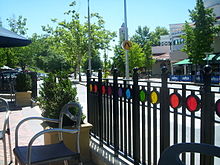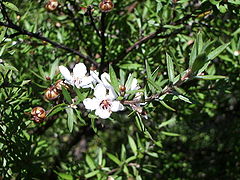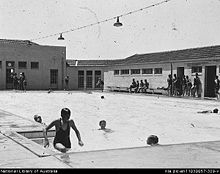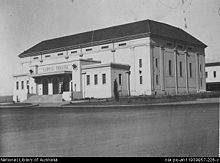- Manuka, Australian Capital Territory
-
Manuka (pronounced /ˈmɑːnəkɑː/ mah-nə-kah) is an area in the Inner South district of Canberra, Australia covering parts of the suburbs of Griffith and Forrest. Manuka Shops, Manuka Oval, Manuka Swimming Pool, and Manuka Circle take their name from the park in the area.
Contents
Origin of name
The precinct is named after Manuka Circle, the street which forms the northern boundary of the precinct. Manuka Circle was on Walter Burley Griffin's original plan for Canberra and named after the New Zealand tea tree Leptospermum scoparium. The name Manuka is somewhat peculiar in that it is pronounced by local Canberrans differently from the tree from which it gets its name: /ˈmɑːnəkɑː/ (locally [ˈmɐːnəkɐː]) compared to /mɑːˈnuːkə/ ([mɐːˈnʉːkə]) for the tree.
When Griffin drew up his plans in 1912, there was still some optimism that New Zealand might join the Federation of Australia. Griffin's plans included eight avenues radiating out from Capital Hill named after the capitals of the six states, the capital of the Northern Territory and the capital of New Zealand. Before the name Wellington Avenue was gazetted it was realised that New Zealand was not going to become part of a federation of Australasia and the name was replaced by Canberra Avenue. Griffin planned that the state capital city avenues were terminated with a park named after the generic botanical name for a native plant from that particular site; for example, Telopea Park is named after the waratah, the floral emblem of New South Wales, and is at the end of Sydney Avenue, named after the capital of New South Wales. Another remnant of Griffin's nomenclature was the Wellington Hotel, formerly on the corner of Canberra Avenue and National Circuit which was demolished and replaced by the hotel known in 2005 as "Rydges Capital Hill Canberra".
History
Business allotments for Manuka were included in the first auction of city leases in December 1924. At the same time leases were sold in the city, Braddon, Kingston, Forrest and Red Hill. Lessees were required to erect buildings of approved design on the blocks within three years. The decision to develop business centres at both Kingston (then called Eastlake) and Manuka, which were within half a mile of each other had been made in the absence of Sir John Sulman, the chair of the Federal Capital Advisory Committee. He later recorded his disapproval of the decision. Sulman had designed Manuka and it was intended to be the principal commercial centre on the south side. The decision to allow the development of Eastlake meant that in Manuka investment lagged and building was slow. Eastlake was preferred by residents as a business centre because of the bigger shops and closer proximity to more homes as well as being closer to the previously only substantial shop in the Territory which had been near the Kingston railway station. The opening of the Capitol Theatre and the convent school associated with St Christopher's Catholic cathedral allowed the Manuka businesses to develop competitively.
Facilities associated with Manuka
Shops
Shops were first built in Manuka between 1925 and 1930. In recent years a collection of outdoor cafes has taken over the more utilitarian shops that dominated the area up to the late 1970s. In the 1960s the precinct included a hardware shop, two supermarkets, a large delicatessen, two butchers, a fishmongers, at least one green grocer, several florists, a boot shop and repairer, clothes shops, home wares and furniture shops, several shoe shops, chemists, newsagents, several barbers and hairdressers, a shop selling church candles, ... . Manuka is now known for its restaurants and for some nightclubs.
Manuka Pool
Building work commenced on the pool in July 1930. It was the first swimming pool to be built for the city. Before its completion, Canberrans swam in the Molonglo River and other local swimming holes at the Cotter and Murrumbidgee Rivers. Canberra's first pool was built on the south side as it was closer to more Canberra residents than any northside location. The pool was officially opened on 26 January 1931.[1]
Manuka Oval
See separate article on the Manuka Oval.
St Christopher's Cathedral
St Christopher's Cathedral is adjacent to the shopping district, and is technically located in the suburb of Forrest. The Reverend Father Patrick Haydon was appointed as parish priest of the new Saint Christopher's Parish at Manuka in 1928. He oversaw the building of a convent and school, opened in 1928, and the first stage of Saint Christopher's Pro Cathedral which was completed in 1939. The Catholic community had intended to build a full cathedral on Commonwealth Avenue but their plans were never realised as the depression took away the ability to raise funds for the project and the impetus was never regained.
St Christopher's was finally extended to its present size in 1973, when it became the co-cathedral of the Catholic Archdiocese of Canberra and Goulburn, and more recently the sole cathedral when the former cathedral in Goulburn ceased to be a cathedral of the archdiocese.
Members of the Parliament of Australia often have their year opening prayers at St Christopher's or St. Paul's, usually in February during the first sitting period. [1]. St Christopher's also hosts significant national and diocesan services for the national capital. These include major ecumenical services, because St Chistopher's is the largest church in the national capital of any Christian denomination.
The Manuka site behind the Church is proposed as the site for the ACT Government's Braddon housing redevelopment. The Church and the Government are currently in negotiations.[citation needed]
St Paul's Church, Manuka
The Anglican parish of St John the Baptist Church at Reid provided a church hall on the southside of Canberra at Eastlake (later renamed Kingston), close to the residential development. The hall was much used in the 1920s and a regular congregation gathered there each Sunday with a Sunday school. In the 1930s there was an active choir, football and cricket teams associated with the congregation. In 1933 a building fund was commenced for a new site and permanent church. However as this was during the depression, progress was slow. The foundation stone for the new church was laid by the Governor-General, Baron Gowrie, on 11 December 1938. The church was dedicated on 6 August 1939, five days after the 25th anniversary of the holding of the first Anglican service in the St Paul's Hall at Kingston. It was the first Anglican church to be built in the district since the 1840s. Initially St Paul's was part of the parish of St John's; the parish of St Paul, Canberra, was proclaimed formally on 26 March 1950.
The church is built in a distinctive style that blends art deco and gothic, and has been enlarged twice. The original structure included only the nave. In 1956 a new sanctuary and unusual bell tower were added. In 2001 two more bays were added to the nave, making it the largest Anglican church in Canberra. Its size and location, and the absence of an Anglican cathedral in the national capital, mean that it is often called upon to host major diocesan and national services as well as its parish functions.
The tower contains the only full peal of bells in the Australian Capital Territory. The 8 bells came from a variety of sources including several cast especially in England.
The church also boasts the first major combination (or hybrid) organ in Australia, in which the 3 manual pipe organ has been substantially augmented by custom digital electronic ranks.
ArtSound FM 92.7
Manuka is now the home of radio station ArtSound FM 92.7 MHz. ArtSound moved to premises in the ACT Arts Centre (formerly the Jazz Campus of the School of Music) in early 2007.
ArtSound plays a mix of Jazz, Classical, Roots, Blues, Folk and world music. It was established in the early 1980s under the name Canberra Stereo Public Radio and previously broadcast out of studios in Curtin.
Capitol Theatre
The Capitol Theatre was one of Canberra's most important centres for entertainment in the early life of the city, with many plays and films. The design was to the requirements of the theatre impresario J.C. Williamson. It was opened in 1927 and hosted a reception for the arrival of aviator Bert Hinkler in Canberra in 1928. The theatre was later bulldozed in 1980 and the present Greater Union cinema built on the site. The decision to destroy such an important building of Canberra's heritage was controversial at the time and since.[2]
References
- ^ As compiled by Huggus on behalf of Clive Harvie (c. 1994). That's where I met my wife : a story of the first swimming pool in the National Capital at Canberra. C. Harvie. 2027538.
- Body, A.H. (1986). Firm Still You Stand (The Anglican Church of St John The Baptist, Canberra, Its Parish and Parishioners. 1841-1984). St Johns Parish Council, Canberra, Australia. ISBN 0-9591711-2-6.
- Gibbney, James (1986). Calthorpes' Canberra: The town and community in 1927. Australian Government Publishing Service, Canberra, Australia. ISBN 0-644-04662-7.
- Huggus, compiled on behalf of Clive Harvie (1994?). That's where I met my wife : a story of the first swimming pool in the National Capital at Canberra. C. Harvie, Canberra, Australia. (no ISBN).
- Wigmore, Lionel (1963). The long view : a history of Canberra, Australia's National Capital. F.W. Cheshire, Melbourne, Australia. (no ISBN).
Categories:- Canberra urban places
Wikimedia Foundation. 2010.






